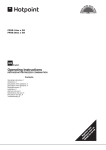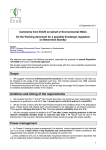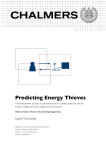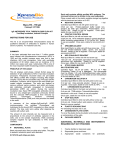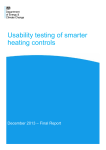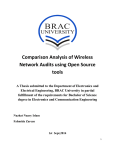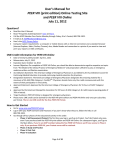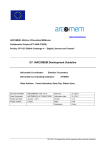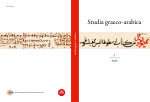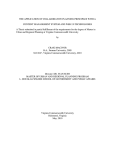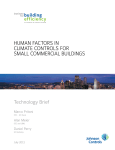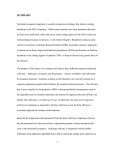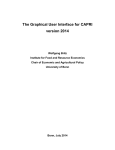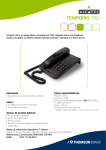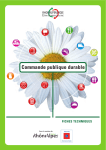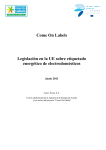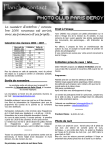Download Don`t just press the button! - Why appliance settings increasingly
Transcript
7-323-15 – Stamatis Sivitos Don’t just press the button! - Why appliance settings increasingly matter for efficiency delivery and rulemaking Stamatis Sivitos European Environmental Citizens’ Organisation for Standardisation (ECOS) 26 rue d’Edimbourg B 1050 Brussels [email protected] Christoforos Spiliotopoulos European Environmental Citizens’ Organisation for Standardisation (ECOS) 26 rue d’Edimbourg B 1050 Brussels [email protected] Rainer Stamminger University of Bonn Nussallee 5 D-53115 Bonn [email protected] Edouard Toulouse Independent consultant 45 rue Faidherbe F-59110 La Madeleine [email protected] Abstract Appliances and energy-using products are getting more energy efficient, but they also tend to become more and more sophisticated with a multiplication of programmes and auxiliary features. The way they are set and used becomes a critical determinant of their real life energy consumption, which can vary greatly depending on a single initial setting or usage routine. Irrational or poorly informed behaviour with respect to appliance energy consumption may be a tangible setback in the path towards a lower energy consuming world. This should be an area of interest and concern for those who seek to achieve energy savings. Yet, user behaviour regarding several energy-using appliances, is still relatively understudied and overlooked. Experience shows that it is often a weak spot in the preparatory work underpinning energy efficient product policies and programmes, and this can hamper their development and adequacy. The recent controversial dispute over the way people use vacuum cleaners in real life and the energy impact of this, during the preparation of EU’s regulations, is an illustration. One particularly interesting aspect is the growing development of so-called ‘eco-modes’. These operating modes are meant to showcase a product’s environmental excellence, but are users actually going for them? In some appliances, ‘Eco-modes’ may be so artificial and far from convenient (e.g. washing machine programmes that last many hours) that in reality they will not be desired and actual energy use will be much higher than claimed. This can have serious policy implications. For instance, if manufacturers are allowed to use these artificial ‘ecomodes’ as the basis for assessing their products’ energy performance, energy labels may mislead consumers, minimum efficiency requirements may become too easy to meet, and a fair and honest comparison between products and manufacturers would be hindered. Insights on current processes to develop measurement standards for EU efficiency regulations show that this is a real threat. This paper discusses these issues, and illustrates them with recent examples. It then provides recommendations to better take product use aspects into account, so that product energy efficiency does not just remain on paper but becomes reality. Introduction Traditionally, energy efficient technologies and appliance regulations are designed to deliver, provided people behave as expected with the products, that is in accordance with the designer’s or decision-maker’s vision. The focus is primarily on the technical design phase before products are placed on the market. There has so far been too little interest and research on what happens in real life after the sale is actually made. With appliances becoming more energy efficient but also more sophisticated and adjustable, the way they are set and used becomes a critical determinant of their real life energy consumption, and an important aspect for policy formulation. Users, in general, pay little attention to product settings, so real life use of products may diverge widely from what would have been expected by engineers and policymakers. This can lead to energy wastage. There is also a risk that the standard way in which products are tested for energy performance is not representative of what many users are actually doing, hence creating a gap in user information and policy reliability. Extent of the issue User-induced variations in appliance energy consumption Available evidence suggests that actual user behaviour regarding energy-using products at home is often inconsistent, and varies hugely across households (Moezzi et al 2010). Some energy metering campaigns have confirmed that there were huge disparities from one home to another. Wide ranges exist even for such ubiquitous loads like refrigeration (Nelson et al 2014). These differences stem not only from differences in appliances, but also from differences in using them. Hence the importance of assessing the extent of the issue, so looking at how much energy may not be saved as expected due to real-life behaviour. When a product is so basic as to have only one operating mode, the risk is relatively limited. Yet, energy-using products and appliances are becoming more and more sophisticated due to the penetration of electronics and smart functionalities. The trend is developing towards more and more programmes and menu settings. While this improves flexibility and programmability if used correctly, it also increases the range of possible sustained deviations from an efficient use. Table 1 below provides cases found in the literature, of the impact on energy consumption of choices regarding user-settings or programmes for several appliance types. Table 1 – Examples of user settings affecting energy consumption Product Impact on energy use Setting or programme Deselecting power management settings and leaving the PC on for long periods PC 70% increase TV 10% to 30% increase TV Around 50% increase Washing machine 30% to 100% increase Dishwasher 20% to 30% increase Using the automatic programme instead of the energy saving Tumble drier Average 25% increase Drying clothes with a programme by-passing the auto-off sensor-drying Watching at a high brightness level compared to a reasonable home-mode setting Setting that transitions to a ‘quick start’ mode for 2 hours before going to normal standby Washing at temperatures higher than 30°C or with fast programmes Data source ECW 2010 Based on Horowitz 2013 and Digital Europe 2012 Based on NRDC et al 2014 BIO 2009 Stiftung Warentest 1 annual figures Based on Calwell 2013 Freezer 16% increase Kettle 30% increase Water heater 6% to 11% increase Hasanuzzaman et al 2008 Lowering the internal temperature setting by 2°C Heating water at 100°C compared to 80°C on a programmable model Setting the tank water temperature at 60°C instead of 50°C Based on BIO 2014 US EPA 2015 Note 1: See Figure 1 below. These examples of variation are sometimes very large - more than the width of one or two classes on energy labels (!), often for little or no visible additional comfort. More concretely, a EU household equipped with average-performing appliances used with the aforementioned settings examples can already consume 500 extra kWh/year, meaning €100 more on annual energy bills2. Why would people fail to use the most sensible settings? Appliances set and used in energy-intensive ways are not just isolated cases. An illustration is the seemingly impressive number of home PCs used without power management on: a very large share of machines according to IVF (2007); confirmed in more recent research (ECW, 2010) that found the issue in 50% of the 50 homes they studied. Another illustration is a survey of consumer behaviour in Germany on dishwashers showing 80% of respondents not using primarily the energy saving programme (Bichler, 2015). Consumers commonly use just one programme (Bichler 2014, Richter 2010b); however this programme is different from consumer to consumer, as shown in Table 2. Table 2: Overview of dishwashing programmes chosen as the main programme 29,1 Richter (2010a) (n = 1209) 12,4 17,0 14,8 7,8 11,3 Stamminger and Streichardt (2009) (n=2599) 8,9 17,7 7,8 -- 8,7 27,7 29,1 6,0 Bichler (2015) – Online-study (n = 3836) 14,5 18,7 14,3 6,4 12,2 17,0 16,9 -- Bichler (2015) - Usage diary study (n = 202) 13,7 22,4 25,7 0,5 11,5 8,2 16,9 1,0 This contrasts with usual consumer statements, where a majority declare energy and water saving as their top priority (Presutto et al 2007, Schmitz and Stamminger 2014). There may be several reasons for this mismatch, including difficulty to identify the best/eco programme, perceived cleaning or drying result, doubts about the programme length, confusion about the energy impact of the various programmes (in particular the performance of the short vs ‘eco’ programme), etc. Stiftung Warentest, the German consumer testing organisation, has been running tests on dishwashers for years. They show that the eco/energy saving programme has the lowest energy consumption, while the automatic and short programmes consume more energy (20 to 30%) (see Figure 1, which also shows that the reduction of energy consumption in the energy saving programme is followed by reductions in the other programmes). 2 Other programmes Normal 60-65 °C Normal 50-55 °C Short Glass/Care Automatic Energy saving / Eco Intensive % of households using mainly this programme Based on own calculations using average-performing products found in houses (2013) and the 2012 average EU electricity price. 7,7 Figure 1. Dishwashers’ average energy consumption of different programmes in Germany (Stiftung Warentest, graphics: University Bonn) Generally, it is probable that some users decide to use non energy efficient or sub-optimal settings or programmes for very deliberate reasons. But for many others it is likely the result of more routine-type behaviour and lack of attention or understanding on the consequences and alternatives. The knowledge about the energy use of appliances and saving opportunities is relatively poor in the general public (Attari et al, 2010); energy-using activities at home are mostly inconspicuous and habitual, engrained by social structures, personal histories, and cultural interpretation, and resulting in sustained habits that can impede more rationale behaviour in terms of avoiding unnecessary energy consumption (Moezzi et al, 2010). Contrary to a common misconception, users do seem to read product instruction manuals -according to available surveys such as Pistochini et al (2013), however a large share may miss the point about energy use in relation to settings (36% of respondents found user manuals incomplete or complex in Pistochini et al (2013), an Italian survey related to white appliances). Another study revealed that more than half of British TV owners never make any adjustment to their TV picture after purchasing the set, potentially using more energy than necessary (Morris, 2012). An understudied problem Market statistics and rulemaking on appliance efficiency are traditionally based on averages, hiding the disparities and complexities of the use of products in real life. The practice of assuming an ‘average behaviour’ saves time and simplifies calculations. User behaviour is often considered to be a given and stable fact, and not influenced and produced by the design of the appliance itself or its interface (Prignot, 2009). The problem is that assumptions about behaviour are often based on overall optimism concerning the energy benefits of pure technological change (Moezzi et al, 2010). The way in which these ‘average behaviours’ are constructed in EU policy reveals weaknesses and oversimplification, due to a lack of data and research. As an illustration, in the preparation of Ecodesign and Energy Labelling regulations the analysis about user behaviour has often proven to be too rudimentary or unsatisfactory. The diversity of practices is not sufficiently acknowledged (Prignot, 2009). A statement confirmed in some of the EU preparatory studies prior to Ecodesign regulations, such as the one on TVs (Fraunhofer, 2007), recognising that the variety of TV use patterns is growing, making it “very difficult” for them to determine averages. Another example has been the controversial discussions about vacuum cleaner usage patterns that revealed major disagreements between stakeholders and a lack of robust knowledge in relation to actual user behaviour (AEA, 2009)3. There have been attempts outside the EU at better understanding and characterising the subtleties of appliance use behaviour, such as the Energy Efficient Use Index concept for standby (Shuma-Iwisi, 2011) or research on the usability of thermostats (Meier et al, 2011), yet we think this is still a relatively unexplored area, especially when it comes to user motivations for selecting settings and programmes. Consequences If real life product use is overlooked or averaged in too simplistic ways, policies and measures directed at cutting energy use may miss important aspects and therefore not deliver the expected results. Besides, standard energy performance ratings for consumer information may be artificial or misleading, if they are done in a way that diverges too much from what a large share of people really experience at home (Calwell, 2013). An actual example may be the washing machine energy label where machines reach declared values of A+++ minus 50% and above, but the programmes behind the label classification are taking so much time that hardly any consumer will use them. The shorter programmes in contrary use much more energy. Can we trust ‘eco-modes’? One particular mode/setting that is increasingly available on appliances and energy-using equipment is the socalled ‘eco’ mode/button. It is supposed to help users reduce their environmental impact easily and to some extent showcase the manufacturer’s green consciousness. It is therefore of particular interest to have a look at this particular mode and understand how relevant and successful it can be at mitigating the issues addressed in the previous part. No clear definition Although the concept of 'eco mode' can be understood as an alternative combination of settings under which a lower (or the lowest) environmental impact / energy consumption is achieved by the product, neither a general nor specific standardised definition nor specifications are available for most product categories. Using an 'ecomode' can affect the operation of a product in different ways: • • • In some water heaters, the eco-button deactivates pre-heating, meaning that the equipment no longer keeps an amount of water constantly hot for use anytime, but would only start heating water when the tap is turned on (Worcester Bosch, 2015). The main consequence is a few-second delay in the delivery of hot water. In some refrigerators, pressing the 'eco-button' adjusts the temperature of the refrigerator and freezer compartments for reduced energy consumption (Samsung, 2015; Hotpoint, 2015). More confusingly, the absence of a clear definition allows sometimes for a variable use of the term 'eco' for different functions and combination of settings even amongst products of the same category. For instance, different car models have eco-buttons that do different things (smooth throttle response, change the transmission programme, adjust the HVAC system, reduce the load for air-conditioning) according to manufacturer and model (Ramsey, 2011). Do eco-modes really save energy? A few examples of doubts about questionable ‘eco-modes’ have been reported. We can mention two of them: • • 3 Tests on an internet gateway model in 2011 have revealed that the eco-modes were not saving more than 1 W power overall (N9ws, 2011), where these eco-modes have been qualified as an 'inefficient gadget'). Figure 2 (from a relatively old model as far as we can tell) shows a washing machine for which the so-called ‘energy saving’ programme was probably a more energy-efficient alternative than the 95°C normal programme, but still at a temperature higher than 60°C and (thus by far not the least consuming option). Unresolved questions such as ‘do people vacuum longer when the cleaning or sucking performance is decreased?’ are important because they have consequences on annual energy use. Figure 2. Washing machine example (Chadwick Mal, 2013) From our experience, this however remains limited. In most cases eco-modes can deliver significant energy savings, especially when they are framed by clear definitions and safeguards to limit potential fraud. An illuminating example is that of washing machines in the EU. Eco-modes are now defined in regulation (Commission Regulation No 1015/2010). They shall be named as ‘standard 60 °C cotton programme’ and ‘standard 40 °C cotton programme’ (to encourage users to use them by default) and shall be clearly identifiable on the programme selection device. They shall be ‘the most efficient programmes in terms of combined energy and water consumptions for washing cotton laundry’. In addition, manufacturers have to declare the energy consumption of the different programmes in instruction manuals. Figure 3 shows an example of declared values found in the manual of an A+++ washing machine model (AEG L 89495 FL). Comparing the consumption for the non-eco cotton 60 °C programme (‘cottons 60 °C’ versus ‘Standard 60 °C cotton’), we see an energy consumption that can be more than twice that of the eco- programme for the same amount of load. This factor varies even more for the cotton programmes at 40 °C: almost by a factor of three. In this case, selecting the ecomode does make a huge difference in terms of energy consumption. Figure 3. Extract of an instruction manual for a washing machine (AEG L89495FL) Unfortunately, eco-mode definitions and (minimum) specifications have not been included in most EU product regulations adopted thus far. The price to pay for saving energy ‘Eco’ modes and programmes save energy by optimising the functioning of the product and limiting the use of the most energy intensive components and processes. This may come at a certain price in terms of user comfort or services. In ‘eco’ conditions, the product usually takes some more time to produce the desired output and may not have all side functionalities available at the same time. For instance, a product in ‘eco-standby’ mode may require a few more seconds to warm up compared to normal standby. This may be annoying for some users, but also largely acceptable for others. But there is always a possibility that in order to always show better performance, some eco-modes become so artificial that their use may be considered by users as impractical or troublesome (especially when they are not aware of the savings and benefits at stake). The significant energy consumption reduction achieved in washing machine eco-programmes is not at the cost of a decrease in washing performance (as regulation sets a high level of washing performance in all programmes) but through longer duration to undertake the wash cycle; the energy saving programme often takes one hour more than the non-eco cotton programme. Users who want a quick wash may be surprised and upset by this longer delay. Regrettably, consumers are rarely informed about the rationale for these consequences and these may come as an unfortunate surprise. Regarding washing machines, few people realise that low energy consumption and good performance require increasing the time of the wash (at a given washing technology). A probable reason for this is that the information concerning programme duration is not easily accessible to consumers prior to purchase. Consequently, consumers do not pay sufficient attention to programme durations at the time of purchase, and manufacturers are not encouraged to make progress on this parameter. It has to be noted, however, that increased energy efficiency does not necessarily come with a significant sacrifice. For example, a tumble drier that runs in an eco-mode using a sensor to stop the cycle when the load is sufficiently dry will not only save energy but also potentially time, compared to a programme with a pre-fixed duration. Although it is not possible to draw firm conclusions from the anecdotal evidence we have presented, it is reasonable to assume that eco-modes in general can save a significant amount of energy (based on e.g. the values presented in table 1) at a performance level that may often seem acceptable, provided the impact on other aspects (such as programme duration) remains reasonable and users are well-informed of the gains. Policy implications As we have seen, the energy performance of a product can vary greatly depending on the way it is set and used. This variation has three major implications for policies aimed at increasing energy efficiency: It is an important issue to consider when deciding how the energy performance of a product is to be assessed in order to underpin fair and effective energy labels and minimum energy performance requirements. • It suggests that product regulations should not only address product technical efficiency, but also ways to better ensure that products are used in the most efficient ways. • It can have an influence on policy delivery and evaluation, because if people do not use products in the way expected, the final amount of energy savings can be quite different. In the following part, we particularly elaborate on the first point. • Importance of settings in measurements Product energy efficiency regulations need to be underpinned by accurate measurement and test methods. Designing measurement methods is a crucial – yet often overlooked – part of the rulemaking process (Toulouse, 2014). With respect to EU Ecodesign and Energy Labelling regulations, the European Commission issues standardisation requests to European Standardisation Organisations (CEN and CENELEC) in order to develop harmonised European standards (EN)4 for measurement methods. The purpose of these standards is to describe an agreed methodology to measure the energy performance of the products and support the regulations in question. These standards are then published as ‘harmonised’, meaning that they are recognised in all EU Member States as providing presumption of conformity with EU regulations. Measurement standards are crucial in order to have clearly defined, repeatable, reproducible and accurate methodologies, which allow for the fair 4 The International Organisation for Standardization (ISO) defines a standard as “a document that provides requirements, specifications, guidelines or characteristics that can be used consistently to ensure that materials, products, processes and services are fit for their purpose” (ISO; 2015). assessment and comparison of products, as well as ensuring that effective regulations with adequate results can be adopted. The conditions in which products are tested usually matter, sometimes very much. Particularly as different modes or settings (and their multiple combinations) may significantly impact the energy consumption. As an example, the decision in the EU to test TV sets in a home mode instead of (brighter) out of the box mode has resulted in a 30% improvement of the apparent energy performance (Digital Europe, 2012). Therefore, an agreed and well-specified definition of the settings under which the performance of products is tested, declared and verified, appears as an essential condition for the standards to deliver their aforementioned purposes. Risks of grey areas: the water heater example Yet, this condition is not always fulfilled, or not sufficiently. In this case, each manufacturer or market surveillance authority may conduct tests under random or most favourable settings, each time impeding fair or accurate comparison. A representative example of such a situation is water heaters in the EU (Spiliotopoulos, 2014). As described earlier, some water heaters provide an ‘eco-button’ deactivating the function of constantly keeping an amount of water hot. The measurement standards currently under development and candidate for harmonisation do not specify clearly the mode that products should be tested under. Manufacturers would be free to test their products under any mode. It is logical to assume that they would choose the one demonstrating the best energy performance, i.e. the one using the eco-button. This would give their products a much higher energy rating and ease the compliance with minimum performance requirements adopted in 2013. However, as mentioned earlier, the 'eco-button' mode may not be the most frequently used in real life, especially if it stretches energy performance artificially at a too high cost for user comfort. The consequences of this would be threefold: • • • For the environment, as energy savings initially expected by the product regulations would be hindered by the way products are tested, For consumers, who would be kept unaware of the mode their appliance was tested in to achieve the efficiency rating on energy labels, and potentially surprised to receive higher than expected energy bills, For the industry, a fair and honest comparison of products would be jeopardised. In the absence of harmonised standards to support the EU regulations on water heaters at the time of publication (in August 2013), the European Commission issued a Communication (Official Journal of the European Union, 2014) with ‘transitional’ methods to be used until harmonised standards are completed. These methods did not specify the testing mode/settings either. Having recognised the problem and need to specify the mode under which the tests should be conducted (and in the absence of sufficient user behaviour research in the area of water heaters to characterise the most representative of real-life mode), the European Commission specified that each water heater shall be tested in the "out of the box-mode”. This mode has been defined as "the standard operating condition, setting or mode set by the manufacturer at factory level, to be active immediately after the appliance installation, suitable for normal use by the end-user according to the water tapping pattern for which the product has been designed and placed on the market" (Official Journal of the European Union, 2014). The rationale behind this specification lies on the fact that if a consumer does not intervene on the product by changing the settings after it is installed, it will run according to the energy class specified on the energy label. However, this solution only partly resolves the issue, as the product could be set by the manufacturer in an ecomode by default, though later on switched by the consumer to another mode with higher energy consumption, without the user knowing the energy consumption impact of this change. Making ‘eco’ the default option? It would not necessarily be a bad thing if products are tested in their eco-mode, provided this mode is really efficient, convenient, clear to consumers, and most importantly, largely used by default. Coming back to the example of washing machines, it has been shown earlier that the eco programmes are those, which use the least amount of energy with a satisfying level of washing performance. However, users are not sufficiently aware of the longer programme duration: as an illustration, the EU energy label misses information regarding the duration of the programme in which the product was tested. This is unfortunate, as some consumer surveys have shown a higher level of acceptance of longer programme durations if the relevant information (e.g. that such programmes can save energy) has been communicated to users (Schmitz and Stamminger, 2014). In addition, when policies fail to sufficiently address important aspects, it leaves room for manufacturers to optimise one visible performance criteria (e.g. energy use) at the cost of another (such as longer programme duration). Communicating more on programme durations, as well as foreseeing relevant provisions during the revision of the related regulations, would urge manufacturers to address and compete on this aspect. Recommendations for policymakers and related stakeholders Based on the previous discussion and findings, there appears to be room for improvement in the way settings and ‘eco-modes’ are considered in product policies, and the repercussions this can have from an environmental, financial and competitiveness perspective. We provide hereunder a non-exhaustive list of recommendations: • • • • • • With regards to measurement methods used for energy labels and minimum performance requirements, the conditions in which a product is measured should always be crystal clear and representative of real life use, while being proportionate to related cost and time considerations. If a product is only tested in an ‘ecomode’ with reduced functionalities, it is important to guarantee that this mode is reasonable and not only designed to lower the product environmental or energy impact in an artificial way that would hardly take place in real homes. To achieve this in the EU, a safeguard principle could be added to the framework Ecodesign and Energy Labelling Directives (such as: ‘The conditions in which products are tested for conformity shall be realistic and correspond to a normal or common usage pattern. Where products have different operating modes or programmes, the testing conditions shall be made sufficiently precise in the implementing measure. In particular, it should be avoided that a product is only tested in an eco-mode with reduced functionalities specifically designed to lower the product's environmental impact if it is not the default mode.’) For all relevant product categories, definitions or minimum specifications for ‘eco-modes’ could be agreed and specified, to make sure that these modes really save energy and are appealing for users. A harmonised way across appliances of depicting the eco-mode (wording, pictogram…) could have a positive learning effect on consumers; it could motivate users not using eco modes to switch to these, while facilitating use for existing users. When eco-modes are well-framed and have clear benefits, consumers should be encouraged to use them as a normal practice. Legislation can play a role, through enforcing generic requirements such as: obligation to deliver products with energy management features enabled by default, mandatory sensors to stop programmes when the expected result is achieved, displaying the eco-mode in a clear way on the control panel, etc. In addition, it would be fair to better inform consumers about the modes/settings in which a product has been rated, to avoid gaps between the perceived energy performance at the time of purchase and the real life one afterwards, but also motivate sustainable behaviour. This could be added in some way to the energy labels, particularly in a future digitalised version, as well as information about the important parameters that are relevant to users in relation to settings, such as programme duration for white appliances or reactivation time for eco-standby modes. Other means of user information and awareness raising on the benefits of eco-modes and eco-settings should be reinforced; not only provided in instruction manuals, as those may not be read and/or be understood but through additional means, such as communication tools (e.g. ‘I try 30°C’ campaign from the International Association for Soaps, Detergents and Maintenance Products in 2013 on low temperature wash [AISE, 2013])5, as well as education/information on energy saving behaviours through education as well as consumer organisations. Finally, more research should be undertaken on real life user behaviour of energy using and energy related products, especially the motivations and practices related to settings and mode selection. Such investigations would in particular be very useful for new -or the revisions of existing- EU Ecodesign and Energy Labelling regulations. In concrete terms, it means that the academic world should be more stimulated to look into these topics, and authors of technical studies prior to regulations should spend more time on these as well, with a view to identifying a representative group of settings to base regulatory requirements on; if not possible, adjust the requirements to make sure the performance of products is improved in all major modes (and not just one). References AEA (2009). Work on Preparatory Studies for Eco-Design Requirements of EuPs (II) Lot 17 Vacuum Cleaners, Final Report AISE (2013). http://www.iprefer30.eu/, (date visited: 19/01/2015) 5 Mottos could include: longer washing times save real energy! Attari Shahzeen Z., DeKayb Michael L., Davidson Cliff I., de Bruinc Wändi (2010). Public perceptions of energy consumption and savings. Bichler Sandra, Gorny Susanne, Stamminger Rainer (2013). Are German consumers using their dishwashers in an energy efficient way? Presented at the 2013 EEDAL conference. Bichler Sandra,(2014). Verbraucherakzeptanz von Energieeinsparpotentialen an automatischen Geschirrspülmaschinen. Shaker-Verlag, Aachen 2014. Bichler Sandra (2015). Dishwashing habits in Germany– How to improve sustainability? To be publishedBIO Intelligence Service in collaboration with Giraffe and Intertek for DEFRA (2009). Reducing the environmental impact of clothes cleaning. BIO by Deloitte (2014). Preparatory Study to establish the Ecodesign Working Plan 2015-2017. Draft consulted in December 2014. Calwell Chris (2013). Are Test Procedures Passing the Test? Ensuring That Measured Results Are Representative of Energy Use in the Field. Presented at the 2013 EEDAL conference. Chadwick Mal (2013). What does that eco button do? 10:10. url: http://www.1010uk.org/articles/what-does-ecobutton-do (date visited: 10/03/2015) Denkenberger et al. (2014). The time is ripe for paying attention to clothes drying technology and policy in relation to efficiency and drying time. ECOVA, August 2014. Digital Europe (2012). Pre-consultation forum response to the report entitled ‘CF paper on the review of TV regulations and displays’. ECW (2010).Electricity Savings Opportunities for Home Electronics and Other Plug-in Devices in Minnesota Homes: A technical and behavioral field assessment. Fraunhofer (2007). EuP Preparatory Studies “Televisions” (Lot 5), Final Report on Task 3,“Consumer Behaviour and Local Infrastructure” Hasanuzzaman M., Saidur R., Masjuki H.H. (2008). Investigation of Energy Consumption and Energy Savings of Refrigerator-Freezer During Open and Closed Door Condition, Journal of Applied Sciences. Horowitz Noah (2013). Energy Use Trends, Policies and Savings Opportunities Related to Consumer Electronics. Presented at the 2013 eceee Summer Study. Hotpoint FFUG 18xx x O3/FFUG 20xx x O3 Operating Instructions (2015). url: http://kitchen.manualsonline.com/manuals/mfg/hotpoint/ffug_18xx_x_o3.html?p=1 (date visited: 05/01/2015) ISO (2015). What is a standard. url: http://www.iso.org/iso/home/standards.htm (date visited: 05/01/2015) IVF (2007). Preparatory Study for Ecodesign Requirements – Personal Computers and Computer Monitors. Meier Alan, Aragon Cecilia, Peffer Therese, Perry Daniel, Pritoni Marco (2011). Facilitating energy savings through enhanced usability of thermostats. Presented at the 2011 eceee Summer Study. Moezzi Mithra, Lutzenhiser Loren (2010). What’s Missing in Theories of the Residential Energy User. Presented at the 2010 ACEEE Summer Study. Morris Jonathan (2012), Is your TV picture perfectly optimised? Research says no. url: http://www.smarttvradar.com/4375/is-your-tv-picture-perfectly-optimised-research-says-no/ (date visited: 05/01/2015) N9ws (2011). Eco-Conception: le mode Eco de la neufbox Evolution est-il efficace ? url: http://www.n9ws.com/n9ws-eco-conception-3a-le-mode-eco-de-la-neufbox-evolution-est-il-efficace-3f2716.html (date visited: 05/01/2015) Nelson Dennis J., Berrisford Andrew J., Xu Jiaying (2014). MELs: What Have We Found through End-use Metering? Presented at the 2014 ACEEE Summer Study. NRDC, ACEEE, and ASAP (2014). Comments on ENERGY STAR Version 7.0, Draft 2 Specification for Televisions. Official Journal of the European Union (2014). C 207, 3 July http://eur-lex.europa.eu/legalcontent/EN/TXT/?uri=uriserv:OJ.C_.2014.207.01.0022.01.ENG Pistochini P., Zangheri P., Fumagalli S., Chiesa M., Bottani G., Gallo E., Leonardi G., Longoni V., Scarano V., Tarantini V., Villani M. G. (2013). Energy&Appliances 2015 project: a new approach for testing appliances with respect to end-users behaviour. Presutto M, Stamminger R, Scaldoni R, Mebane W, Esposito R. (2007). Preparatory study of Eco-design requirements of EuPs; Lot 14: Domestic Washing Machines and Dishwashers; Task 3-5. ISIS. Prignot Nicolas, Wallenborn Grégoire (2009). Standardisation of practices and representations of users in the ecodesign Directive. Presented at the 2009 eceee Summer Study. Ramsey (2011). What's This "Eco" Button In My New Car?, January 2011; http://www.autoblog.com/2011/01/28/car-eco-button/ (date visited: 05/01/2015) Richter CP (2010a). Automatic dishwashers: efficient machines or less efficient consumer habits? International Journal of Consumer Studies 34(2):228-234. Richter CP (2010b). In-house Consumer Study on Dishwashing Habits in Four European Countries: Saving Potentials in Households with Dishwashing machine. Shaker-Verlag Aachen 2010 Samsung RL39 Owner's instructions (2015). url: http://www.manualslib.com/manual/146610/Samsung-Rl39.html#manual (date visited: 05/01/2015) Schmitz A, Stamminger R.(2014). Usage behaviour and related energy consumption of European consumers for washing and drying. Energy Efficiency 7(6):937-954. Shuma-Iwisi Mercy V. (2011). Energy Efficient Use Index: A Parameter for Efficient Energy Behaviour for Operating Electronic Consumer Appliances. Presented at the 2011 EEDAL conference. Spiliotopoulos C. (2014). Major savings lost at the push of a button. http://www.coolproducts.eu/blog/ecobutton-loophole (date visited: 05/01/2015) Stamminger R, Streichardt C. (2009). Selected Aspects of Consumer Behaviour in the Manual and Mechanical Dishwashing in Germany. SOFW-Journal 135(11):7. Toulouse, E. (2014). Developing measurement methods for EU Ecodesign and Energy Labelling measures. A discussion paper. Published by CLASP. US EPA. (2015). Energy efficiency, url: http://www.epa.gov/p2/pubs/energy.htm ((date visited: 05/01/2015) Worcester Bosch (2015). Greenstar 25Si/30Si. USER INSTRUCTIONS & CUSTOMER CARE GUIDE. url: http://www.worcester-bosch.co.uk/cache/file/275/user-manual-for-greenstar-si--manufactured-aug-08--july-09.pdf (date visited: 05/01/2015)











